Reverse osmosis (RO) is one of the most effective ways to purify tap water of contaminants. However, most RO systems feature tanks that act as water reservoirs.
Although these tanks are useful since they allow clean water on-demand, they become a burden if you don’t have the space for them or happen to move a lot. This is why some water treatment brands produce tankless and space-friendly RO units.
In this article, we collected the four absolute best items in this category after conducting months of tests and research.
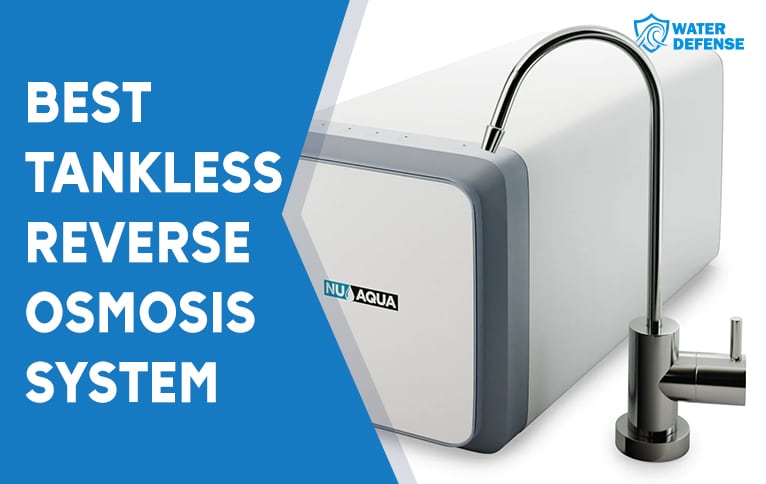
Ultimately, we concluded the WaterDrop G3 P800 system is the undisputed champion of tankless RO systems. For the details on why and more options to explore, read on.
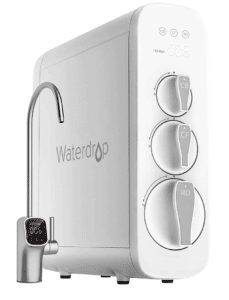
- Filtration process: 7-stage
- Filtration capacity: 800 GPD
- Wastewater ratio: 3:1
- NSF certifications: NSF/ANSI Standards 42, 53, 58, and 372
- Size: L: 18.06”, W: 5.65”, H:17.75”
- Warranty: 1-year warranty with a 30-day return guarantee
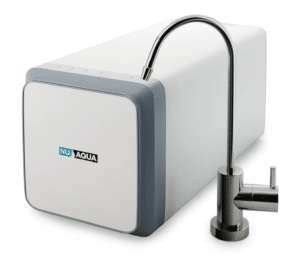
- Filtration process: 4-stage
- Filtration capacity: 600 GPD
- Wastewater ratio: 2:1
- NSF certifications: Not certified
- Size: L: 27”, W: 16.9”, H: 13.7”
- Warranty: 1-year warranty with a 120-day return guarantee
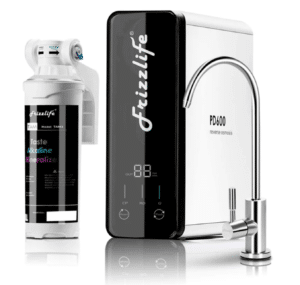
- Filtration process: 7-stage
- Filtration capacity: 600 GPD
- Wastewater ratio: 1.5:1
- NSF certifications: Not certified
- Size: L: 14.7”, W: 5.3”, H: 15.5”
- Warranty: Not provided by the manufacturer
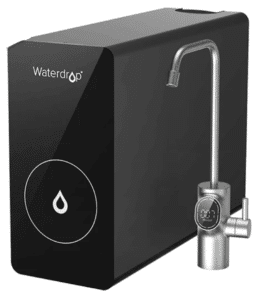
- Filtration process: 6-stage
- Filtration capacity: 600 GPD
- Wastewater ratio: 2:1
- NSF certifications: Not certified
- Size: L: 15.98”, W: 5.98”, H:11.97”
- Warranty: 1-year limited warranty with a 30-day return guarantee
Tankless Reverse Osmosis Systems
WaterDrop G3 P800

- Filtration process: 7-stage
- Filtration capacity: 800 GPD
- Wastewater ratio: 3:1
- NSF certifications: NSF/ANSI Standards 42, 53, 58, and 372
- Size: L: 18.06”, W: 5.65”, H:17.75”
- Warranty: 1-year warranty with a 30-day return guarantee
- Extremely effective seven-stage filtration process
- UV sterilizer kills 99.9% of bacteria and viruses
- Compact
- NSF-certified
- 800 GPD filtration capacity
- 3:1 wastewater ratio
- Only one year of warranty
- Removes healthy minerals
- Expensive
WaterDrop G3 P800 is our favorite tankless RO unit and our favorite reverse osmosis system overall – with good reason. This extremely compact unit produces 800 gallons of clean water daily and efficiently removes the most prominent tap water thanks to its seven-stage process.
This process comprises the following filtration elements:
- A polypropylene cotton layer that blocks sediment and large particles
- A scale inhibitor layer that diminishes hard water molecules
- An activated carbon block that takes care of aesthetic impurities such as color and chlorine
- A second polypropylene cotton layer that removes remaining sediment particles
- A 0.0001-micron semipermeable reverse osmosis membrane that eviscerates hazardous chemical contaminants and heavy metals
- A post-activated carbon block that handles turbidity
- A UV sterilizer that eliminates pathogenic organisms like bacteria and viruses
Additionally, the WaterDrop unit has NSF certifications (NSF/ANSI Standards 42, 53, 58, and 372), supporting its scientific claims. Consequently, it comes with a detailed performance data sheet listing the contaminants it removes with their reduction rates.
We also like this WaterDrop product because it doesn’t compromise water flow when dealing with contaminants. It produces a single cup of water in under six seconds, and its filtration capacity of 800 gallons per day (GPD) is unprecedented in the niche.
What’s even better is the UV sterilizer it comes with. It’s the only tankless RO system on the market with a UV sterilizer.
RO systems usually waste lots of water during filtration, but WaterDrop G3 P800’s 3:1 wastewater ratio (wasting one cup of water for every three cups of clean water) is among the lowest on the market.
One aspect we don’t like about WaterDrop G3 P800 is that the manufacturer provides only one year of warranty. However, it also offers a 30-day return option if you’re unsatisfied.
In addition, the unit removes healthy minerals as all RO systems do, so the water it produces will be calcium- and magnesium-free.
Lastly, it’s the most expensive tankless RO equipment currently available.
Nu Aqua Efficiency Series 600

- Filtration process: 4-stage
- Filtration capacity: 600 GPD
- Wastewater ratio: 2:1
- NSF certifications: Not certified
- Size: L: 27”, W: 16.9”, H: 13.7”
- Warranty: 1-year warranty with a 120-day return guarantee
- Efficient 4-stage filtration process
- Budget-friendly
- You can connect it to your fridge
- 600 GPD filtration capacity
- 2:1 wastewater ratio
- 120-day money-back guarantee
- Removes healthy minerals
- Doesn’t have NSF certifications or a performance data sheet
- Only one-year warranty
- Not as compact as other units on our list
The Nu Aqua Efficiency Series 600 doesn’t boast the impressive numbers of the WaterDrop G3 P800 model. However, it’s still an effective RO system with a 0.0001-micron semipermeable membrane that blocks many hazardous pollutants and provides a more budget-friendly alternative to our top product.
The filtration process of the Nu Aqua unit is a four-stage one.
- The first cartridge houses polypropylene cotton that prevents sediment from entering the system
- There’s also an activated carbon block in the first cartridge, there to remove aesthetic impurities (color, odor, taste, and chlorine) and volatile organic compounds (VOCs).
- The second cartridge utilizes granular activated carbon. This filtration media is effective against chemicals, herbicides, pesticides, and some heavy metals.
- The last stage is the RO membrane. It handles heavy metals (including lead, chromium, and copper), chemicals, mineral salts, and fluoride.
You can also connect the Nu Aqua device to your fridge. That way, you’ll get clean, safe, and cold water from your fridge’s spigot.
The Nu Aqua Efficiency Series Tankless System entertains a 600 GPD filtration capacity. Although that number pales in comparison to the capacity of the WaterDrop model, it’s still a decent number.
The same can be said of its wastewater ratio. The Nu Aqua Tankless RO unit entertains a 2:1 wastewater ratio. It’s not as good as WaterDrop, but it’s still a remarkable number, considering the industry standard (1:1).
Yet, the main problem with RO systems, namely the fact that they remove healthy minerals alongside dangerous pollutants, also applies to the Nu Aqua device.
In addition, unlike WaterDrop G3 P800, this tankless RO item doesn’t have any NSF certifications or performance data sheets.
Its warranty option isn’t any better either. Similar to WaterDrop, Nu Aqua offers only a one-year warranty. However, it has a better money-back guarantee, valid for 120 days if you want to return it.
Finally, it’s not as compact as the other units on our list, so if your space is very limited, it may not be the best choice for you.
Frizzlife Tankless Reverse Osmosis System

- Filtration process: 7-stage
- Filtration capacity: 600 GPD
- Wastewater ratio: 1.5:1
- NSF certifications: Not certified
- Size: L: 14.7”, W: 5.3”, H: 15.5”
- Warranty: Not provided by the manufacturer
- Highly efficient 0.0001-micron RO membrane
- Features a remineralizer that restores water alkalinity
- 600 GPD flow rate
- Extremely compact
- Budget-friendly
- Appealing design and LED display
- Not eco-friendly due to its high wastewater ratio
- No NSF certifications or performance data sheet
- No info on the warranty
If you want to purchase a RO system that doesn’t remove healthy minerals alongside dangerous contaminants, we present the Frizzlife Tankless Reverse Osmosis System.
While entertaining a similar price tag and filtration capacity to the Nu Aqua model, it raises the alkalinity of the water, making it the healthiest tankless RO option for you and your family.
As we mentioned when reviewing the two products above, due to the small pore sizes of the RO membranes the RO process increases the acidity of the water. Since the standard American diet is mainly acidic, many people prefer to alkalize their water. The Frizzlife device is the right fit for that job.
Similarly to the WaterDrop unit, the Frizzlife model employs a seven-stage process. In this process, sediment filters and carbon blocks remove large particles and aesthetic impurities.
Then, a 0.0001-micron RO membrane enters the picture and removes total dissolved solids, heavy metals such as lead and hexavalent chromium, micro-organic contaminants like cysts, and inorganic and organic pollutants including PFAS, microplastics, and fluoride.
In the final stage, Frizzlife’s alkaline remineralizer adjusts the pH of the water to 7.5 by reintroducing minerals and eliminating acidity associated with RO devices.
It’s good to know that the Frizzlife device doesn’t sacrifice flow rate during that complicated water treatment process. Instead, it has a 600 GPD filtration capacity, producing a cup of clean water in under ten seconds.
We also liked its high-quality and appealing design and easy-to-decipher LED display.
But what we particularly like about it is that it’s an even more compact unit than the WaterDrop.
That being said, Frizzlife’s 1.5:1 wastewater ratio makes it the least eco-friendly product on our list.
Similar to the Nu Aqua unit, it doesn’t have any NSF certifications, nor does it come with a performance data sheet.
Additionally, the manufacturer doesn’t provide any info on the warranty or money-back options, which is one of the reasons why this particular device is not our runner-up despite its merits.
WaterDrop D6 Under-Sink Tankless Reverse Osmosis System

- Filtration process: 6-stage
- Filtration capacity: 600 GPD
- Wastewater ratio: 2:1
- NSF certifications: Not certified
- Size: L: 15.98”, W: 5.98”, H:11.97”
- Warranty: 1-year limited warranty with a 30-day return guarantee
- Price: $379
- Affordable
- 6-stage filtration process
- 600 GPD filtration capacity
- Compact
- 2:1 wastewater ratio
- Excellent LED display
- Removes healthy minerals
- Produces acidic water
- No NSF certifications
- Humble warranty
It’s understandable if you don’t want to break the bank for a reverse osmosis system, especially if you rely on municipal tap water. In such cases, a water filter that removes the most prominent tap water contaminants (for example, lead, arsenic, PFAS, and microplastics) will suffice. The WaterDrop D6 RO System does that with a price tag of only $379.
Although the WaterDrop D6 model employs a less impressive method than its high-end sibling, WaterDrop G3 P800’s treatment process still has six stages. The six stages include two polypropylene sediment filters, two activated carbon layers, one microfiltration media, and one 0.0001 semipermeable RO membrane.
As such, it successfully removes sediment, aesthetic impurities, total dissolved solids, VOCs, the most dangerous heavy metals, PFAS, hard water minerals and salt, and chemicals.
When it comes to filtration capacity, it’s once again more modest than its 800 GPD sibling with only 600 GPD. However, that number equals the filtration capacities of the Nu Aqua and Frizzlife.
Similarly, it has a higher wastewater ratio than the G3 P800 model, as it sends one cup down the drain to produce one cup of clean water. But it’s still more eco-friendly than the Frizzlife model and on par with the Nu Aqua one.
It also has a slick design and an LED display informing you when to change the filters.
Yet, unlike the WaterDrop G3 model, this WaterDrop device isn’t tested by a third party, so it neither has NSF certifications nor a performance data sheet.
Similarly to the other WaterDrop model and the Nu Aqua one, it removes healthy minerals, producing acidic water.
Finally, WaterDrop D6 comes with a limited one-year warranty and a 30-day money-back guarantee. Unfortunately, although these numbers are industry-standard, they don’t inspire strong confidence.
Frequently Asked Questions
Let’s answer the most frequently asked questions regarding tankless reverse osmosis systems.
In the RO process, the devices push the incoming water through a semipermeable membrane. Although the pore size of this membrane changes depending on the manufacturer and model, it’s often 0.0001 microns.
With such a microscopic pore size, contaminants with larger molecules can’t make their way through. So, RO membranes only allow water particles to pass to the other side.
Most reverse osmosis systems utilize a 0.0001-micron pore size. That microscopic pore size blocks many contaminants, from the smallest total dissolved solids to the large particles of rust or heavy metals like lead.
Yes, reverse osmosis removes healthy minerals from water. That’s why some manufacturers like Frizzlife and APEC Industries include a remineralizer or an alkalizer in their filtration processes.
Healthy minerals such as calcium, magnesium, and bicarbonates are essential for our health and necessary in our diets. Plus, they make the water alkaline. When removed, the water becomes acidic, one of the main criticisms against the RO process.
RO systems with tanks provide contaminant-free water on demand without any dip in water flow since there’s always some clean water on standby. In contrast, tankless units take more time to fill a single cup.
Even the tankless systems with the highest filtration capacity, namely WaterDrop G3 P800, will take at least six seconds to fill a cup with water. On the other hand, systems that come with tanks will do it in one or two seconds.
However, systems that feature tanks take up too much space under sinks. Such bulkiness also creates problems if you’re traveling often.
Tankless systems, on the other hand, are compact and portable.
If you’re worried about contaminants in your water and are short of space under your sink, you should buy a tankless RO unit.
The WaterDrop G3 P800 model is the most efficient tankless RO system, both in the sense of contaminants it removes and filtration capacity.
WaterDrop G3 sports a seven-stage filtration process. The filtration media employed in different stages successfully remove contaminants. In addition, the last and unique filtration stage of WaterDrop G3 is an ultraviolet sterilizer that frees water from pathogens like bacteria and viruses.
In terms of filtration capacity, it’s matchless, too, thanks to its 800 GPD rate. Such a rate means it fills a cup with water in six seconds, making it the quickest tankless RO item on the market.
On average, you can purchase a tankless RO unit for about $500. However, the price range of the devices on our list is $300 to $1,000.
For instance, our favorite product, WaterDrop G3 P800, costs $999.
On the other hand, our budget-friendly recommendation, WaterDrop D6, costs only $379.
Conclusion
Tankless RO systems are an excellent way to access contaminant-free water without sacrificing too much under-the-sink space. That’s why they have been so popular lately.
The WaterDrop G3 P800 Tankless RO System is the best device in its category. It removes many contaminants due to its ultra-efficient seven-stage filtration process, and its 800 GPD filtration capacity and 3:1 wastewater ratio are the best on the market.
However, if you don’t want to pay too much for a tankless reverse osmosis unit, the Nu Aqua Efficiency Series 600 is a good alternative. Its four-stage process, 600 GPD filtration capacity, and 2:1 wastewater ratio make it a worthy runner-up to WaterDrop G3.
Are you looking for a RO system that doesn’t produce acidic water? The Frizzlife Tankless Reverse Osmosis System features a remineralizer that raises the alkalinity of water.
Lastly, if you’re in the market for a budget-friendly and effective product, WaterDrop D6 is the obvious choice. It features a remarkable six-stage process, 600 GPD filtration capacity, and a decent wastewater ratio of 2:1 while only costing $379.